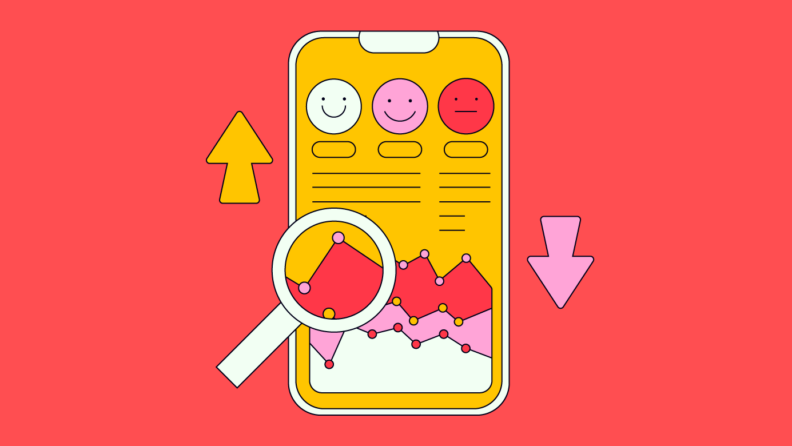With 77% of businesses using social media to reach customers, social media marketing is at the front of everyone’s mind. With a good social media strategy, you can raise brand awareness, increase sales, and build customer loyalty.
But, with different platforms, algorithms, and content types, how do you know which metrics to track? What does a social media report include? Is your influencer marketing campaign working, or is it not worth the price tag?
Fine tuning all your data points can provide a better picture of the customer experience with your brand online. I’m here to help you make sense of the data provided by your social media analytics software so you can reap that ROI. Think of these tools as the social version of marketing analytics software.
What is Social Media Analytics?
Social media analytics, as defined by Gartner, is the practice of collecting data from various social media networks and systematically analyzing it to make informed business decisions.
It goes beyond tracking likes and shares; it's about converting the vast ocean of social media data into actionable insights that can steer you towards success.
To put it simply, social media analytics can be the North Star for marketing teams, leading to strategic decision-making and optimized results.
Why Social Media Analytics are Important
Social media analysis is important because it uncovers data that can sharpen your social strategy and move the metrics that matter. These include:
Setting Marketing Goals
Social media is part of the larger marketing strategy, and it is important to align social media objectives with broader marketing KPIs such as pipeline contribution, product adoption, and retention.
For SaaS teams, this means mapping social KPIs to goals that move the business. Think increasing free trial signups, boosting webinar attendance, or driving user-generated content. Without goal alignment, you're just posting for engagement, not impact.
Trendspotting
Trendspotting is the act of identifying emerging topics, behaviors, or content formats gaining traction across social channels.
For SaaS brands, trendspotting is about timing product narratives, campaign launches, and thought leadership to match cultural and industry moments. Spotting a shift early (like the rise of AI prompts or quiet quitting) lets you lead the conversation, not just follow it. Platforms like X (Twitter) and Reddit are goldmines here if you're listening.
Value Perception
Want to know what customers really think about your brand? Social media is the perfect place for understanding how your audience perceives the usefulness, relevance, and pricing of your product.
Social media offers unfiltered insight into how people talk about your features and pricing tiers. Are users praising your UX or griping about support? Are they comparing you to a cheaper competitor? SaaS brands can extract these insights to refine positioning, surface differentiators, and sharpen GTM strategy.
Brand Sentiment
Brand sentiment analysis involves gauging how audiences feel about your brand based on tone, keywords, and reactions in social conversations.
In SaaS, brand trust is a long game, and sentiment signals whether you’re building loyalty or losing ground. AI-driven sentiment tools (like Talkwalker or Sprinklr) help CMOs monitor real-time reactions to launches, outages, or competitor moves. Used well, this is a reputation radar that guides PR, product, and support teams.
Personalization
Personalization is the key to capturing and retaining audience attention, and social media analytics can help with customizing content based on user preferences. When 71% of consumers expect companies to deliver personalized interactions and 76% get frustrated when it doesn’t happen, that's important.
By analyzing which types of content resonate the most with different segments of the audience, you can create targeted and compelling content that drives engagement and builds brand loyalty.
Proving ROI
Proving social ROI means quantifying the return on investment from social media initiatives, often tied to revenue, leads, or cost savings.
Executive teams need hard numbers, not follower counts. Proving ROI is how social teams earn larger budgets, justify tools, and claim a seat at the strategy table. For SaaS, this means tying social metrics to CAC, MQLs, CLV, and pipeline acceleration. Attribution models may be imperfect, but directional insight beats silence.
The 5 Types of Social Media Analytics
Not all social media analytics are created equal. To drive impact, SaaS leaders need to segment their approach across five core types of data analytics, each offering a different lens on customer behavior, market signals, and campaign performance. Here’s how they break down, and why they matter:
1. Performance Analytics
Performance metrics track how your content performs across social media channels.
This is your baseline: without performance data, you’re flying blind. For SaaS teams running content-led demand gen, knowing which LinkedIn posts drive demo signups or which webinar clips earn the most replay time can help allocate resources and double down on what’s actually moving the needle.
Key metrics include:
- Impressions
- Clicks
- Shares
- Comments
- Conversions
- Sales
Most often, social media professionals will add up their total likes, comments, shares, and saves, and divide the total by the number of followers. Then, simply multiply by 100 to get a percentage. While TikTok has the best engagement rate, a good one to shoot for across all platforms is, on average, 1.75%.
2. Audience Analytics
Audience Analytics provides insights into who your followers are. These help SaaS marketers segment their ICPs (ideal customer profiles) or target audience and refine messaging. It’s especially crucial in ABM strategies, where social media content must resonate with both users and decision-makers. Key social media metrics include:
- Job titles
- Interests
- Demographics
- Preferred platforms
- Device
3. Competitive Analysis
Competitive Analysis involves comparing your performance, engagement, and content strategy to direct competitors and industry benchmarks.
In a crowded SaaS category, knowing what competitors are saying, and how the market is responding, gives you a strategic edge. It’s less about imitation, more about identifying whitespace and avoiding echo chambers.
4. Sentiment Analysis
Sentiment analysis is the use of natural language processing (NLP) to interpret how people feel about your brand. Sentiment analytics gives you the emotional pulse behind the metrics. For SaaS brands navigating pricing changes, outages, or launches, this is your early-warning system and feedback loop rolled into one.
For example, if you want to know how your customers feel about your after-sale service, you could create a one-question survey to rate your customer’s satisfaction. Add up all the scores and divide the sum by the number of responses. Then multiply by 100 to get your CSAT score as a percentage.
Positive sentiment in social media conversations can be a precursor to brand advocacy, while negative sentiment may highlight areas that need improvement. Aim to have your percentage between 75% and 85%.
5. Influencer and Paid Analytics
Influencer and paid analytics measure the effectiveness of influencer collaborations and paid social campaigns. Whether you’re working with micro-creators or running LinkedIn lead gen ads, these numbers are your accountability layer. Paid campaigns in SaaS are often scrutinized for CAC and funnel velocity, so optimizing here is essential. Here are some metrics to track:
- Cost Per Click (CTC)
- Cost Per Acquisition (CPA)
- Click Through Rate (CTR)
- Conversion Rate
- Return on Ad Spend (ROAS)
A good conversion rate for social media is considered to be between 2%-5%. Understanding and optimizing this metric is pivotal for assessing the effectiveness of marketing efforts and fine-tuning strategies accordingly.
Social Media Analytics Tools & Platforms
There are native analytics tools provided by social media platforms themselves, as well as third-party tools that offer a more comprehensive view of performance.
Native Analytics Tools
Social media giants like Facebook, Twitter, and LinkedIn all provide native analytics tools. These tools offer a basic overview of metrics such as likes, shares, follower growth, and comments. While they serve as a good starting point, they may lack the depth needed for a nuanced analysis.
Third-Party Analytics Platforms
For a more sophisticated and detailed analysis, SaaS companies often turn to the best social media analytics tools. Here’s a list of our top 10, with more in-depth information on some of these tools.
Tools such as Hootsuite, Sprout Social, and Buffer provide a more comprehensive view of social media performance. They go beyond basic metrics, offering features like social listening, competitor analysis, and detailed demographic insights.
Hootsuite
Known for its user-friendly interface and advanced social media scheduling capabilities, Hootsuite allows users to manage multiple social media accounts from a single dashboard. Its analytics features provide in-depth insights into engagement and audience behavior.
Sprout Social
This platform is applauded for its robust analytics suite and real-time brand monitoring through it’s social listening tools. Sprout Social empowers SaaS companies with data-driven insights for informed decision-making.
Buffer
Ideal for startups and smaller teams, Buffer simplifies social media management with its straightforward interface. While not as feature-rich as some competitors, it excels in social media post scheduling and offers basic analytics to gauge performance.
Using Data Visualization Techniques
Raw data can be overwhelming and challenging to decipher. Data visualization techniques, such analytics dashboards with charts, graphs, and heatmaps, transform complex datasets into visual representations that are easy to understand. Visualizations not only simplify information but also reveal patterns and trends that might be missed in raw data.
Measuring ROI And Impact On Growth
While engagement and customer satisfaction are essential metrics, marketers must also quantify the return on investment (ROI) of their social media efforts. Understanding the financial impact of social media campaigns is critical for demonstrating value and making informed decisions about resource allocation.
Calculating ROI for Social Media Campaigns
Social media ROI is needed to measure the success of your marketing campaigns. To begin, determine the total cost of the campaign, including expenses for content creation, advertising spend, and any other associated costs. Next, track the campaign's gains, such as increased website traffic, engagement metrics, and conversion rates.
Once you have both the costs and gains, apply the ROI formula: ROI = (Net Gain from Investment / Cost of Investment) x 100.
Net gain is calculated by subtracting the campaign costs from the revenue generated or the value gained. The resulting ROI percentage provides an understanding of the campaign's profitability.
Additionally, consider using tracking tools and analytics platforms to monitor KPIs throughout the campaign, allowing for real-time adjustments and optimization to maximize ROI.
Impact on Customer Lifetime Value
As a campaign generates positive ROI, it not only signifies immediate profitability but also contributes to the long-term value of customers! Engaging and converting customers through social media can lead to increased loyalty, repeat purchases, and a higher likelihood of them becoming brand advocates.
A positive ROI suggests that the resources invested in the social media campaign are sustaining happy customers, thereby extending the customer's lifetime value. By consistently delivering valuable content and maintaining an active online presence, a business can enhance customer retention, foster brand loyalty, and ultimately maximize the overall lifetime value of customers.
And hey, 76% of consumers say they would buy from a brand they feel connected to over a competitor. This underscores the importance of strategic social media campaigns as integral components of a broader customer-centric business strategy.
Analytics for Scaling Strategies
As a SaaS company grows, so do its social media needs. Analytics provides the insights necessary to scale marketing strategies effectively.
Scalability of Campaigns
By analyzing the performance of past campaigns, you can identify scalable strategies that can be replicated for new products, features, or target markets. This data-driven approach to scalability ensures that marketing efforts align with your company's overall growth objectives.
Audience Expansion
Social media analytics helps you understand the demographics and preferences of your existing audience. Armed with this knowledge, you can strategically expand your audience by targeting new segments that align with your product offerings.
Data Analytics Case Studies
How Netflix Uses Analytics to Improve Customer Retention
Netflix did a case study to figure out how to better retain their customers. To work towards that goal, Netflix collected data from every interaction with its 150+ million subscribers. The company then used analytics tools to process the data and evaluate everything from how customers navigate the platform to what they watch.
Netflix has found that a substantial 80% of viewer engagement can be attributed to their recommendation algorithm. Through effective data collection and the application of marketing analytics, the company has refined its recommendation engine, compelling viewers to prolong their watching habits and maintain subscriptions.
The financial impact of this focus on marketing analytics is evident in revenue metrics, with Netflix estimating that its algorithm contributes a staggering $1 billion in value annually, primarily through enhanced customer retention strategies.
Notably, Netflix has outperformed competitors like Hulu and Amazon Prime in terms of customer retention. With an impressive 90% retention rate, the majority of subscribers consistently choose to renew their Netflix subscriptions month after month. In contrast, Amazon Prime exhibits a 75% retention rate, while Hulu lags behind with a rate of 64%.
How Progressive Improves UX Using Data Analytics
Progressive is another great example of a case study where marketing and data collided to create happier customers.
After launching their mobile app, Progressive sought to enhance user experience, streamlining logins to boost satisfaction, customer loyalty, and acquisition.
Utilizing Google Analytics 360 and Google Tag Manager 360 for data visualization, they prioritized mobile devices for testing, cutting testing time by 20%. Examining crash data, Progressive swiftly addressed a server issue, preventing further disruptions. Creating a custom funnel in Google Analytics 360 to assess login paths, they refined workflows, notably increasing logins by 30%.
This case study showcases Progressive's data-driven approach, resulting in streamlined operations and improved user engagement.
Future Trends In Social Media Analytics
As technology continues to advance, the future of social media analytics is poised for exciting developments. Here are some key trends that are shaping the next frontier of data-driven decision-making.
AI and Machine Learning
The integration of Artificial Intelligence (AI) and Machine Learning (ML) into social media analytics is revolutionizing the way companies glean insights from data. The AI market in social media is expected to reach $3.71 billion by 2026! These technologies can analyze vast datasets at incredible speeds, identify patterns, and even predict future trends.
Predictive Analytics
Predictive analytics, powered by AI and ML, allow you to anticipate trends and user behavior. By analyzing historical data and identifying patterns, predictive analytics provides a proactive approach to decision-making.
In the same way that Netflix can predict what movies you may like based on what you’ve already watched, you can stay ahead of the curve, adjusting strategies before the competition reacts.
Sentiment Analysis Advancements
We’re well past combing through positive, negative, and neutral mentions as a percentage of total mentions. AI-driven sentiment analysis and social listening is becoming more sophisticated, enabling companies to understand not just the sentiment but also the context behind social media conversations.
This level of nuance ensures more accurate insights, guiding companies in crafting responses and strategies that resonate with their audience.
Ethical Considerations
As we embrace the power of social media analytics, ethical considerations must be at the forefront of your strategies. Privacy concerns and responsible data usage are paramount to maintaining trust with users.
User Privacy
Respecting user privacy is non-negotiable. You have to be transparent about the data you collect and how it is used. Implementing robust data protection measures ensures that user trust is maintained.
Data Security
Ensuring the security of the data collected is essential. SaaS companies should invest in secure infrastructure and follow best practices to protect user data from unauthorized access or breaches.
Responsible Use of AI
As AI becomes more prevalent in social media analytics, companies must ensure that these technologies are used responsibly. Bias in algorithms and unintended consequences of AI-driven decisions should be actively addressed to maintain ethical standards.
Social Media Monitoring Is a Must
Bottom line, from understanding user sentiment to crafting personalized content, the insights gained from social media analytics can elevate marketing strategies and take your campaign performance to new heights.
By embracing these trends and leveraging the full potential of social media analytics, you'll not only stay ahead of the competition but also foster stronger connections with your audience.
Want more ways to keep your customers engaged and craving more? Subscribe to The CMO newsletter so you don't miss a beat.


